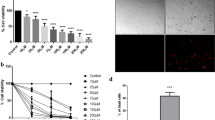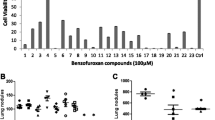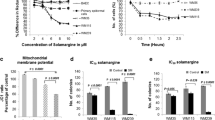Abstract
Purpose
Natural products represent a rich reservoir of potential small molecule inhibitors exhibiting antiproliferative and tumoricidal properties. An example is the isoquinoline alkaloid berberine, which is found in plants such as goldenseal (Hydrastis canadensis). Studies have shown that berberine is able to trigger apoptosis in different malignant cell lines, and can also lead to cell cycle arrest at sub-apoptotic doses. A particularly interesting feature of berberine is the fact that it is a fluorescent molecule, and its uptake and distribution in cells can be studied by flow cytometry and epifluorescence microscopy. To test the relationships between berberine uptake, distribution and cellular effect in melanoma cells, K1735-M2 mouse and WM793 human melanoma cells were treated with different concentrations of berberine, and alterations in cell cycle progression, DNA synthesis, cell proliferation, and cell death measured.
Methods
Cell proliferation was measured by sulforhodamine B assays, cell death by flow cytometry, berberine uptake and distribution by laser scanning confocal microscopy and flow cytometry, cell cycle progression by flow cytometry, and DNA synthesis, M-phase, and mitochondrial effects by immunolabeling and epifluorescence microscopy methods.
Results
In these melanoma cell lines, berberine at low doses (12.5–50 μM) is concentrated in mitochondria and promotes G1 arrest. In contrast, higher doses (over 50 μM) result in cytoplasmic and nuclear berberine accumulation, and G2 arrest. DNA synthesis is not markedly affected by low doses of berberine, but 100 μM is strongly inhibitory. Even at 100 μM, berberine inhibits cell growth with relatively little induction of apoptosis.
Conclusion
Berberine displays multiphasic effects in these malignant cell lines, which are correlated with the concentration and intracellular distribution of this alkaloid. These results help explain some of the conflicting information in the literature regarding the effects of berberine, and suggest that its use in clinical development may be more as a cytostatic agent than a cytotoxic compound.










Similar content being viewed by others
References
Vogel VJ (1990) American Indian medicine, University of Oklahoma Press, Norman
Mantena S, Sharma S, Katiyar S (2006) Berberine, a natural product, induces G1-phase cell cycle arrest and caspase-3-dependent apoptosis in human prostate carcinoma cells. Mol Cancer Ther 5:296–308
Maiti M, Kumar GS (2006) Molecular aspects on the interaction of protoberberine, benzophenanthridine, and aristolochia group of alkaloids with nucleic acid structures and biological perspectives. Med Res Rev (epub ahead of print)
Grycova L, Dostal J, Marek R (2007) Quaternary protoberberine alkaloids. Phytochemistry 68:150–175
Dworkin N (1999) Where have all the flowers gone?––herbal supplements threaten some herb species. Vegetarian Times Sept
Hwang J-M, Kuo H-C, Tseng T-H, Liu J-Y, Chu C-Y (2006) Berberine induces apoptosis through a mitochondria/caspases pathway in human hepatoma cells. Mol Toxicol 80:62–73
Inoue K, Kulsum U, Chowdhury SA, Fujisawa S, Ishihara M, Yokoe I, Sakagami H (2005) Tumor-specific cytotoxicity and apoptosis-inducing activity of berberines. Anticancer Res 25:4053–4059
Jantova S, Cipak L, Cernakova M, Kost’alova D (2003) Effect of berberine on proliferation, cell cycle and apoptosis in HeLa and L1210 cells. J Pharm Pharmacol 55:1143–1149
Jantova S, Cipak L, Letasiova S (2007) Berberine induces apoptosis through a mitochondrial/caspase pathway in human promonocytic U937 cells. Toxicol In Vitro 21:25–31
Lin C-C, Kao S-T, Chen G-W, Ho H-C, Chung J-G (2006) Apoptosis of human leukemia HL-60 cells and murine leukemia WEHI-3 cells induced by berberine through the activation of caspase-3. Anticancer Res 26:227–242
Lin JP, Yang JS, Lee JH, Hsieh WT, Chung JG (2006) Berberine induces cell cycle arrest and apoptosis in human gastric carcinoma SNU-5 cell line. World J Gastroenterol 12:21–28
Mantena SK, Sharma SD, Katiyar SK (2006) Berberine inhibits growth, induces G1 arrest and apoptosis in human epidermoid carcinoma A431 cells by regulatin Cdki-Cdk–cyclin cascade, disruption of mitochondrial membrane potential and cleavage of caspace-3 and PARP. Carcinogenesis (epub ahead of print)
Skehan P, Storeng R, Scudiero D, Monks A, McMahan J, Vistica D, Warren JT, Bokesch H, Kenny S, Boyd MR (1990) New colorimetric cytotoxicity assay for anticancer-drug screening. J Natl Cancer Inst 82:1107–1112
Holy J, Lamont G, Perkins E (2006) Disruption of nucleocytoplasmic trafficking of cyclin D1 and topoisomerase II by sanguinarine. BMC Cell Biol 7:13–25
Berlin G, Enerback L (1983) Fluorescent berberine binding as a marker of secretory activity in mast cells. Int Arch Allergy Appl Immunol 71:332–339
Dimlich RV, Meineke HA, Reilly FK, McCuskey RS (1980) The fluorescent staining of heparin in mast cells using berberine sulfate: compatibility with paraformaldehyde or o-phthalaldehyde induced fluorescence and metachromasia. Stain Technol 55:217–223
Reyes R, Ramirez G, Delgado NM (2004) Fluorescent berberine binding as a marker of internal glycosaminoglycans sulfate in bovine oocytes and sperm cells. Arch Androl 50:327–332
Curtis SK, Cowden RR (1981) Four fluorochromes for the demonstration and microfluoreometric estimation of RNA. Histochemistry 72:39–48
Gong GQ, Zong ZX, Song YM (1999) Spectrofluorometric determination of DNA and RNA with berberine. Spectrochim Acta A Mol Biomol Spectrosc 55A:1903–1907
Molero ML, Stockert JC (1981) Fluorescence reaction of chromatin and basophilic cytoplasm by berberine sulfate. Cell Mol Biol Incl Cyto Enzymol 27:523–525
Talwalkar SS, Vaidya AB, Godse C, Vaidya A, Vaidya R (2005) Plasmodium DNA fluoresces with berberine: a novel approach for diagnosis of malarial parasites. Am J Clin Pathol 124:408–412
Borodina VM, Zelenin AV (1977) Fluorescence microscopy demonstration of mitochondria in tissue culture cells using berberine. Tsitologiia 19:1067–1068
Mikes V, Dadak V (1983) Berberine derivatives as cationic fluorescent probes for the investigation of the energized state of mitochondria. Biochim Biophys Acta 723:231–239
Slaninova I, Taborska E, Bochorakova H, Slanina J (2001) Interaction of benzo[c]phenanthridine and protoberberine alkaloids with animal and yeast cells. Cell Biol Toxicol 17(1):51–63
Yang IW, Chou CC, Yung BY (1996) Dose-dependent effects of berberine on cell cycle pause and apoptosis in Balb/c 3T3 cells. Naunyn Schmiedebergs Arch Pharmacol 354:102–108
Min YD, Yang MC, Lee KH, Kim KR, Choi SU, Lee KR (2006) Protoberberine alkaloids and their reversal activity of P-gp expressed multidrug resistance (MDR) from the rhizome of Coptis japonica Makino. Arch Pharm Res 29:757–761
He L, Liu GQ (2002) Interaction of multidrug resistance reversal agents with P-glycoprotein ATPase activity on blood–brain barrier. Acta Pharmacol Sin 23:423–429
Lin HL, Liu TY, Wu CW, Chi CW (1999) Berberine modulates expression of mdr1 gene product and the responses of digestive track cancer cells to paclitaxel. Br J Cancer 81:416–422
Shitan N, Tanaka M, Terai K, Ueda K, Yazaki K (2007) Human MDR1 and MRP1 recognize berberine as their transport substrate. Biosci Biotechnol Biochem 71:242–245
Zuo F, Nakamura N, Akao T, Hattori M (2006) Pharmacokinetics of berberine and its main metabolites in conventional and pseudo germ-free rats determined by liquid chromatography/ion trap mass spectrometry. Drug Metab Dispos 34:2064–2072
Chen CM, Chang HC (1995) Determination of berberine in plasma, urine and bile by high-performance liquid chromatography. J Chromatogr B 665:117–123
Pan JF, Yu C, Zhu DY, Zhang H, Zeng JF, Jiang SH, Ren JY (2002) Identification of three sulfate-conjugated metabolites of berberine chloride in healthy volunteer’s urine after oral administration. Acta Pharmacol Sin 23:77–82
Hoshi A, Ikekawa T, Ikeda Y, Shirakawa S, Iigo M (1976) Antitumor activity of berberrubine derivatives. Gann 67:321–325
Kobayashi Y, Tamashita Y, Fujii N, Takaboshi K, Kawakami T, Kawamura M, Mizukami T, Nakano H (1995) Inhibitors of DNA topoisomerase I and II isolated from the Coptis rhizomes. Planta Med 61:414–418
Makhey D, Gatto B, Yu C, Liu A, Liu LF, LaVoie E, Edmond J (1995) Protoberberine alkaloids and related compounds as dual inhibitors of mammalian topoisomerase I and II. Med Chem Res 5:1–12
Letasiova S, Jantova S, Muckova M, Theiszova M (2005) Antiproliferative activity of berberine in vitro and in vivo. Biomed Pap Med Fac Univ Palacky Olomouc Czech Repub 149:461–463
Barreto MC, Pinto RE, Arrabaca JD, Pavao ML (2003) Inhibition of mouse liver respiration by Chelidonium majus isoquinoline alkaloids. Toxicol Lett 146:37–47
Jantova S, Letasiova S, Brezova V, Cipak L, Labaj J (2006) Photochemical and phototoxic activity of berberine on murine fibroblast NIH-3T3 and Ehrlich ascites carcinoma cells. J Photochem Photobiol B 85:163–176
Lin C-C, Lin S-Y, Chung J-G, Lin J-P, Chen C-W, Kao S-T (2006) Down-regulation of cyclin B1 and up-regulation of Wee1 by berberine promotes entry of leukemia cells into the G2/M-phase of the cell cycle. Anticancer Res 26:1097–1104
Letasiova S, Jantova S, Cipak L, Muckova M (2006) Berberine-antiproliferative activity in vitro and induction of apoptosis/necrosis of the U937 and B16 cells. Cancer Lett 239:254–262
Holley RW, Kiernan JA (1974) Control of the initiation of DNA synthesis in 3T3 cells: low-molecular weight nutrients. Proc Natl Acad Sci USA 71:2942–2945
VanDenBogert BC, Kernebeek Gv, Leij Ld, Kroon AM (1986) Inhibition of mitochondrial protein synthesis leads to proliferation arrest in the G1-phase of the cell cycle. Cancer Lett 32:41–51
Jones RG, Plas DR, Kubek S, Buzzai M, Mu J, Xu Y, Birnbaum MJ, Thompson CB (2005) AMP-activated protein kinase induces a p53-dependent metabolic checkpoint. Mol Cell 18:283–293
Mandal S, Guptan P, Owusu-Ansah E, Banerjee U (2006) Mitochondrial regulation of cell cycle progression during development as revealed by the tenured mutation in Drosophila. Dev Cell 9:843–854
Gemin A, Sweet S, Preston TJ, Singh G (2005) Regulation of the cell cycle in response to inhibition of mitochondrial generated energy. Biochem Biophys Res Commun 332:1122–1132
Letasiova S, Jantova S, Miko M, Ovadekova R, Horvathova M (2006) Effect of berberine on proliferation, biosynthesis of macromolecules, cell cycle and induction of intercalation with DNA, dsDNA damage and apoptosis in Ehrlich ascites carcinoma cells. J Pharm Pharmacol 58:263–270
Bunz F, Dutriaux A, Lengauer C, Waldman T, Zhou S, Brown JP, Sedivy FM, Kinzler KW, Vogelstein B (1998) Requirement for p53 and p21 to sustain G2 arrest after DNA damage. Science 282:1497–1501
Taylor WR, Stark GR (2001) Regulation of the G2/M transition by p53. Oncogene 20:1803–1815
Acknowledgments
This work was supported by a gift from the Ladies Auxiliary of the Veterans of Foreign Wars, and by the Portuguese Luso-American Foundation. The authors wish to thank Dr Amy Greene for her generous help with flow cytometry.
Author information
Authors and Affiliations
Corresponding author
Rights and permissions
About this article
Cite this article
Serafim, T.L., Oliveira, P.J., Sardao, V.A. et al. Different concentrations of berberine result in distinct cellular localization patterns and cell cycle effects in a melanoma cell line. Cancer Chemother Pharmacol 61, 1007–1018 (2008). https://doi.org/10.1007/s00280-007-0558-9
Received:
Accepted:
Published:
Issue Date:
DOI: https://doi.org/10.1007/s00280-007-0558-9




